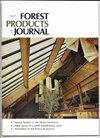木材提取物:木材废弃物的主要种类、功能特性、应用领域和研究方向
IF 1.2
4区 农林科学
Q3 FORESTRY
引用次数: 2
摘要
木材中所含的提取物是在各个领域(如医药、化妆品、农产品)具有很高附加值的化合物。这些提取物可分为四类:脂质成分(萜烯和萜类)、蜡和脂肪、酚类化合物和生物碱。这篇综述特别侧重于描述木材废料中所含的主要萃取物家族,以及它们的性质和迄今为止的潜在应用。简要介绍了几种提取木材提取物的常规技术,以期对我国木材废弃物进行资源化利用。这些萃取物,特别是酚类化合物,分为几类:简单酚类、木脂素、类黄酮和单宁。它们具有化学和生物特性,如抗氧化剂、抗自由基、抗白蚁、抗真菌、抗癌、1型人类免疫缺陷病毒抑制剂、抗诱变剂和抗菌特性。它们也用于食品保鲜以及木材保护。这一审查总结了应该关注我们环境中大量木材废料的可用性的兴趣,这远非一个问题,可能是解决某些当前和未来问题的办法。本文章由计算机程序翻译,如有差异,请以英文原文为准。
Wood Extractives: Main Families, Functional Properties, Fields of Application and Interest of Wood Waste
The extractives contained in wood are compounds with a very high added value in various fields (e.g., pharmaceuticals, cosmetics, agri-food). These extractives can be classified into four groups: lipid components (terpenes and terpenoids), waxes and fats, phenolic compounds, and alkaloids. This review is particularly focused on the description of the main families of extractives contained in wood waste, with their properties and the potential applications made to date. It also makes a brief report on some conventional techniques for extracting wood extractives, with an eye toward recovering wood waste in our country. These extractives, particularly phenolic compounds, fall into several categories: simple phenols, lignans, flavonoids and tannins. They have chemical and biological properties such as antioxidants, antiradicals, anti-termites, antifungals, anticancer, inhibitors of type 1 human immunodeficiency virus, antimutagenics, and antimicrobial properties. They are also used in food preservation as well as wood protection. This review sums up the interest that should be focused on the availability in large quantities of wood waste in our environment, which, far from being a problem, could be the solution to certain current and future problems.
求助全文
通过发布文献求助,成功后即可免费获取论文全文。
去求助
来源期刊

Forest Products Journal
工程技术-材料科学:纸与木材
CiteScore
2.10
自引率
11.10%
发文量
30
审稿时长
6-12 weeks
期刊介绍:
Forest Products Journal (FPJ) is the source of information for industry leaders, researchers, teachers, students, and everyone interested in today''s forest products industry.
The Forest Products Journal is well respected for publishing high-quality peer-reviewed technical research findings at the applied or practical level that reflect the current state of wood science and technology. Articles suitable as Technical Notes are brief notes (generally 1,200 words or less) that describe new or improved equipment or techniques; report on findings produced as by-products of major studies; or outline progress to date on long-term projects.
 求助内容:
求助内容: 应助结果提醒方式:
应助结果提醒方式:


